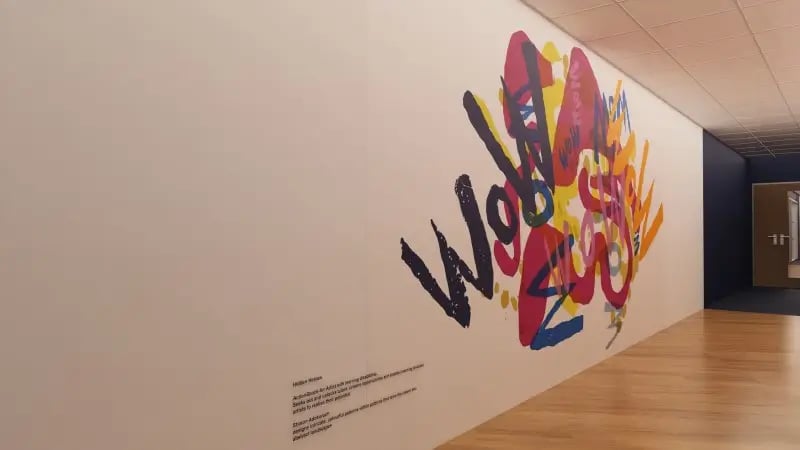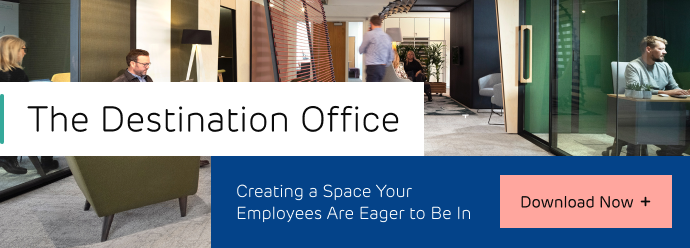For decades companies have used artwork to make their offices more prestigious and pleasing places to work. Now office decor is being used in more holistic ways to promote wellness and productivity. This blog post explores how a space can be finished to delight, motivate and inspire.
Why office decor matters
How we decorate our office walls can influence the way workers and visitors feel when they come into our buildings. An office with no pictures may feel sterile and unwelcoming. But research has shown it can also have a chilling effect on productivity.
A study by the University of Exeter into the relationship between artwork in the office and employee wellbeing, concluded that the addition of plants and pictures to a workspace can have a significant effect on motivation and output:
“Offices with artwork on their walls are 17% more productive than those without.”
How office decor creates a powerful design aesthetic
But office decoration means more than what goes on the walls.
It’s about creating a joined up design aesthetic that can thread its way through a property and actively support the way you want to work.
As companies continue their effort to bring colleagues back to the workspace more regularly, using office decor to create a welcoming and exciting vibe can become part of your recipe for the ‘destination office’.
What can office decor do for you?
The right design and decor can help:
-
Reflect your business culture and values
-
Make workers and visitors feel welcome and ‘at home’
-
Stimulate creativity and new ways of thinking
-
Create zones of calm and focus
-
Create a sense of locality and identity
And it’s not just about 2D artwork
A thoughtful approach to office design and decoration can incorporate:
-
Sculpture
-
Lighting
-
Soft furnishings
-
Bespoke design features
-
Accessories (books, games, statement furniture)
9 ways to use office decor to inspire and attract
We asked Rachel Brown, senior designer at Insightful Environments, to share her top insights into finishing workspaces with impactful decor.
1. Use bespoke design features to add personality
Dominic Harris, designer at Cinimod Studio, often creates works which react to passers-by; a wall of butterflies which beat their wings, or a cascading virtual waterfall you can dip your hands into.

Source: Every Wing Has A Silver Lining, by Dominic Harris.
Commissioned by Norwegian Cruises.
This kind of kinetic decor can help make an office a more attractive work destination. For example, green walls can help create calming spaces where workers can find peace and tranquillity they can’t find at home.
But all kinds of bespoke design features can add interest and intrigue to an office.
Insightful Environments recently commissioned this piece of wall art for a client through the London charity, ActionSpace. ActionSpace is a visual arts organisation that supports learning-disabled artists. They seek out and unlock talent, create opportunities and enable learning-disabled artists to realise their potential.
The piece is a powerful statement of personality and purpose that speaks to the client's sense of creativity:

Source: Hidden Heroes, by ActionSpace artist Sharon Adokorach
“A momentary distraction is definitely not a bad thing in the workplace. Art has historically always been about escape, and we all need is an escape sometimes.”
Dominic Harris
2. Use accessories to help zoning
Modern offices are often zoned, with storage solutions like lockers and cabinets used as room dividers. But this approach can lead to a sterile look. Using accessories like books, plants and ceramics to decorate these often bulky pieces of furniture, can soften the appearance of a zoned workspace.
3. Create a sense of locality through design
Original artwork or prints of local landmarks and views can always bring a sense of locality and place into what could be a soulless corporate office.
But perhaps, more original, is the use of particular objects, textiles or finishes that stylistically represent what your region is famous for.
A great example of the use of regionality is AXIS Architecture’s interior design for HSBC’s Global IT Hub in Sheffield. Around their office, you can see decorative references to Sheffield’s history and its proximity to Yorkshire’s farming heartland.

Source: AXIS Architecture
Across the building you can see life-size and highly coloured models of sheep, bringing a sense of fun and the great outdoors to a city building. Elsewhere, a giant model tree is the focal point for a socialising area.
4. Make the decor part of your ESG programmes
Commissioning local artists is another great way to anchor your building into the town or region where you work.
And there are lots of ways to go about this. The art consultancy dot-art in Liverpool works with companies to commission art from local artists for their office spaces and provide a useful guide to the whole process.
Participating companies can benefit from a more inspiring workplace and demonstrate their commitment to supporting a regional, artistic community.
Using local artists working in locally sourced materials can add a unique twist to your sustainability credentials.
5. Make your decor meaningful
Decorating personal workstations with photos and momentos is traditionally a way to bring a touch of home into the office. But where hot-desking is common and there is a clean desk policy, personalising workspaces may require a more communal emphasis.
Rachel suggests enhancing collaborative spaces to reflect the company's community spirit and values. For instance, adding pinboards that showcase personal highlights like colleagues’ marathon runs, pictures from holidays and events, or even postcards of favourite artworks.
6. Use lighting
We shouldn’t think of decoration as just physical design finishes - lighting can be used, not simply to illuminate, but to create moments of drama or calm in an office.
In this redesign of the BFI’s meeting spaces, Cinimod Studio used natural light filtered through glass to create beautiful, changing patterns on their basement walls.

Source: Cinimod Studio
7. Books to furnish a room
Books can be used to help add personality and interest to an office space. For design and creative firms, the large Taschen books artfully on shelves can be a great source of visual inspiration for visitors and workers. But quirky and vintage volumes related to your specialist field can also be a welcome distraction from intense work and even spark new ways of thinking.
A specialist interior designer can source and curate a whole range of titles to stimulate and delight.
8. Game on
Ping-pong tables, shuffleboards, and a host of other games can provide much-needed distraction and entertainment in offices located in boring industrial estates. But a simple chess board laid out in a quiet nook can also provide opportunities for quiet connection and focused thought.
9. But remember, art is a question of taste
It’s a short step from unique and quirky to controversial. Therefore, businesses looking to dress their spaces with art should commission and curate carefully.
The team at Pfizer landed in hot water when they chose a piece of sculpture from their extensive collection to decorate a shared, communal space:
“A cement sculpture by Jo-Ann Brody depicting a nude woman with a small head and exaggerated hips was removed and replaced with another Brody sculpture, Hands Up, after some female employees felt it was demeaning.”
Source: New York Times
Who needs art anyway?
Many corporations have amassed extensive collections of expensive artwork over the years. British Airways, Saatchi and Saatchi, Lloyds of London are among those with minor masterpieces hanging in their offices with even more in storage. But you don’t need a personal art collection to finish your space creatively.
How a design company can help you dress your space - tips for success
As part of your workplace design process, everyone should consider how art and accessorising can add to your overall employee value proposition - and the experience of visitors to your offices.
-
Don’t forget to finish your space! Companies often forget the final creative finish and when they move into newly renovated spaces are met with a clinical and unwelcoming feel.
-
Find a creative team with a track record in inventive, interior design. They can help you hit the right note in artistic finish to complement your style. Remember, in the wrong hands, bold, inspirational creativity can end up being impractical or overbearing.
-
Your designers should work with your brand team to understand your values and aesthetics - in order to commission the right kind of art and decorative touches.
-
Your designers could also conduct listening sessions with your workers to get feedback and inspiration from them about what workplace art inspires them
-
Your design team should be able to use pilot spaces and software to help you envisage the impact of artistic and decorative choices ‘in situ’.
-
Encourage creative repurposing and the use of local artists and materials to find unique and smart ways of using budget.









